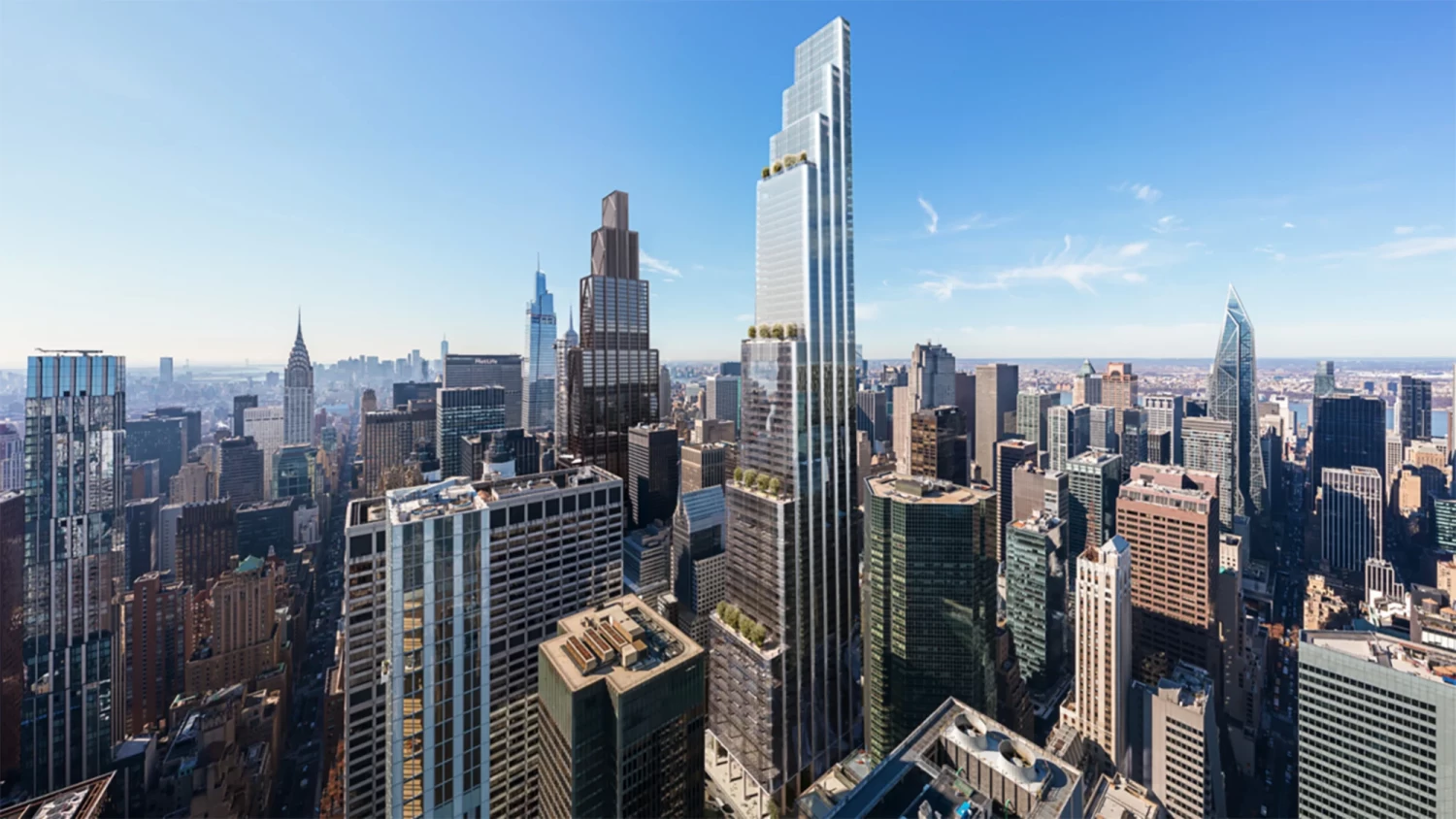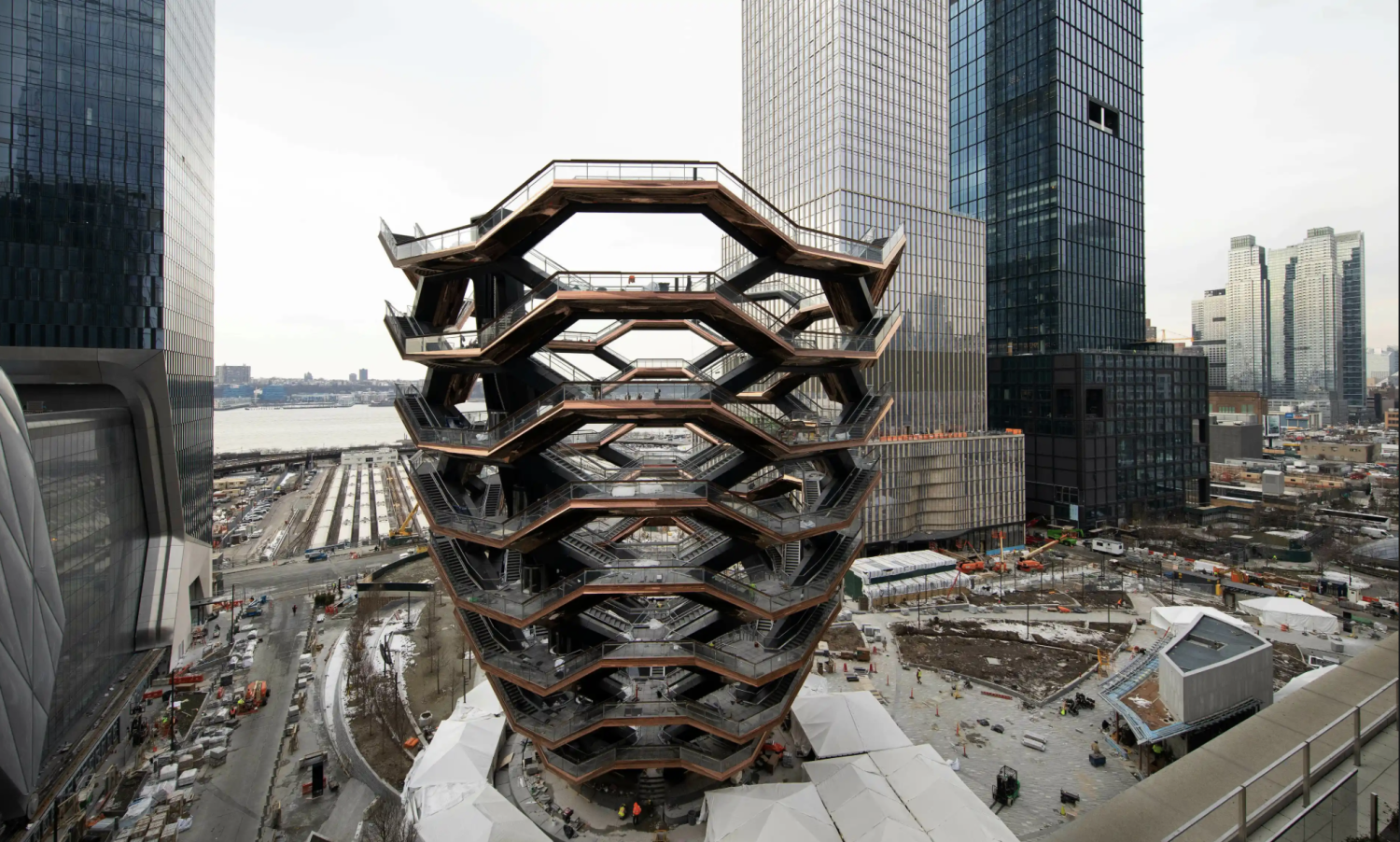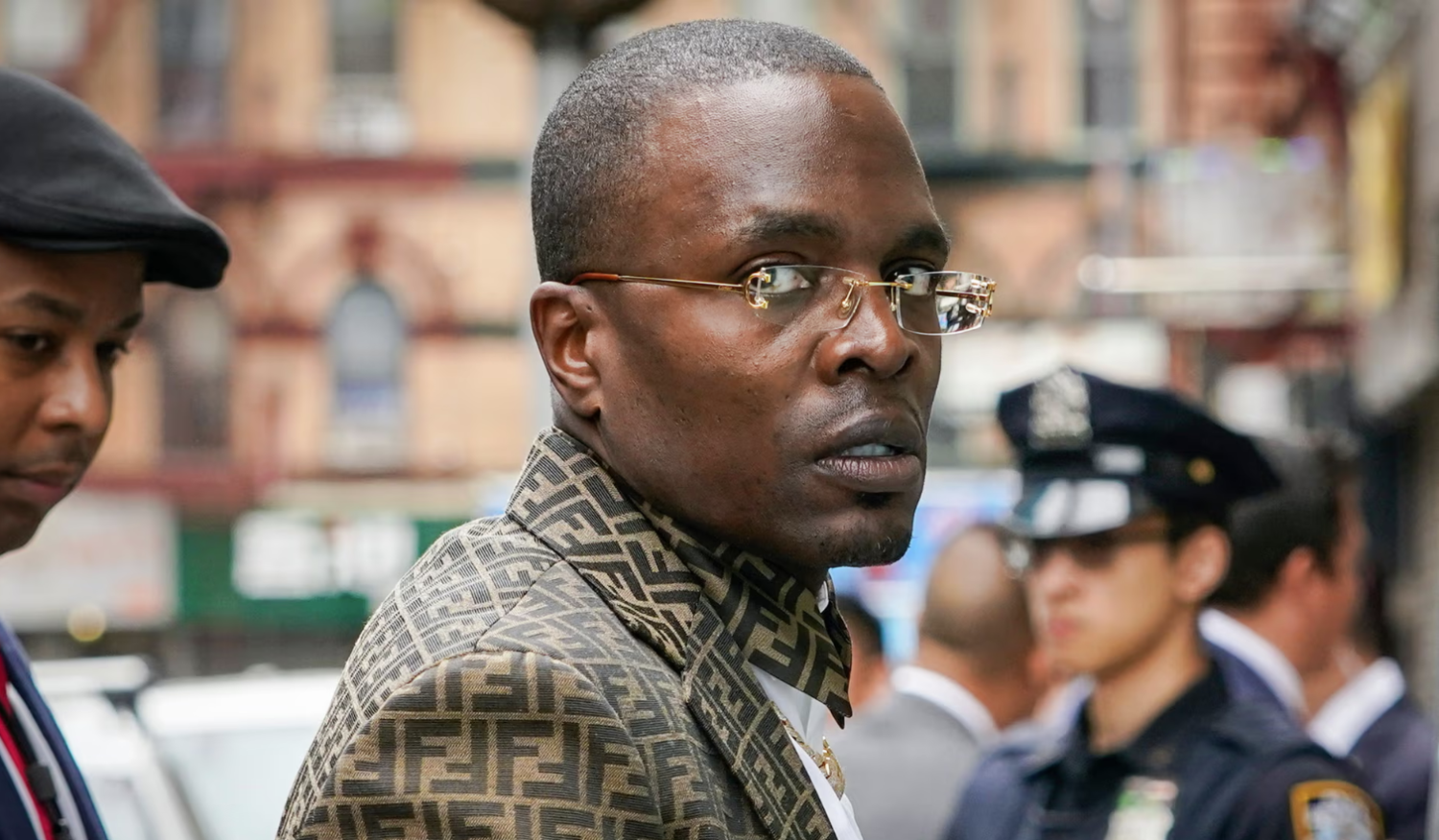This article is more than
3 year oldPerforming to an empty Times Square

Joana Toro for Vox
Once Nadia decided to become a Times Square street performer, it took her a while to choose which character she’d be. She started out as Harley Quinn, then spent some time as a Ninja Turtle before finally landing on Minnie Mouse.
She would have to compete with a sea of other Minnies, snapping pictures with tourists for tips, but Nadia thought she could stand out in her elaborate pink gown and golden crown with lights on it. “If I’m going to do this, I’d like to create a fantasy world to do it right,” she says. She learned to mimic Minnie’s movements. But the voice would be harder for Nadia, who is from Mexico and speaks limited English.
Playing a character in Times Square wasn’t like playing in the local stage productions her parents put on when she was growing up, or what she’d imagined for her life in the United States when she arrived as a student to study communications. The work itself is hard — it means standing outside for hours in the cold, heat, snow, or rain for four, five, or even six days a week. Some days, Nadia, who is 32, could make $100. Others, it was as little as $10.
:no_upscale()/cdn.vox-cdn.com/uploads/chorus_asset/file/22290689/VOX_one_JoanaToro36.jpg)
For many passersby, costumed characters are to be avoided, not embraced. Still, she felt like the money was decent, especially if she worked hard enough for it. “Being your own boss, you can go two ways,” she says, speaking Spanish, like most of the workers interviewed by Vox for this story. “You can be lazy and not ask enough of yourself, or you can commit to it and be good at it.”
That is, until a pandemic hits, and it turns your world upside down. When your job depends on the presence of other people, what happens when the people aren’t there?
Few jobs are as contingent on crowds as the jobs in Times Square. The area is a compilation of mini economies, including street vendors, artists, souvenir shops, bus ticket agents, and even people selling CDs. Some of the work is formal, but much of it is not, including that of street performers and costumed characters, who can number 300 in Times Square at peak times, according to city estimates.
:no_upscale()/cdn.vox-cdn.com/uploads/chorus_asset/file/22290690/VOX_one_JoanaToro27.jpg)
crowds back to the once-busy corridor, giving performers a rare good day at work.
:no_upscale()/cdn.vox-cdn.com/uploads/chorus_asset/file/22290692/VOX_DOS_JoanaToro021.jpg)
The dearth of visitors, particularly from abroad, has sent many in search of other work.
They are at once a highly visible and invisible presence. Mostly immigrants, many undocumented, they do work most people wouldn’t envy — trying to entice people to take a picture with them in hopes of earning a few dollars, a transaction that hinges solely on the client’s generosity. Costumed characters work entirely for themselves.
The characters have become a staple of the Times Square experience, part of the fabric of an area with a rich history as a tourist destination and a symbol of New York City. It’s also an area most New Yorkers steer clear of.
Life behind the mask is difficult during normal times; during the pandemic, it is impossible. There are no tourists, meaning there are no tips. And for many, including Nadia, her partner — the Mickey to her Minnie — and their daughter, there’s no help from the government, either. They are undocumented immigrants, so they can’t collect unemployment and haven’t been eligible for stimulus checks. (Nadia and her partner, along with others in this story, asked that Vox not use their last names for their protection.)
“We have to work double the amount; we have to ration food, obviously. We’re asking churches for help. Fun? Forget it, we can’t afford it,” Nadia says. “You don’t know what’s going to happen, if things will get worse. And the little savings we had are gone.”
Covid-19 has devastated the economy of Times Square. Broadway is shut down, hotels are empty, restaurants and offices are shuttered. Tourism has fallen off a cliff. Usually bustling with so many people you can barely make your way around, the area is now desolate. Those trying to cater to tourists often outnumber the actual tourists. In a way, it is Times Square in its most stripped-down form: The lights and billboards are still there, and so are the workers who keep everything running. What’s missing is everyone else.
The Times Square Alliance, which promotes business in the area, estimates that prior to the pandemic, an average of 360,000 pedestrians walked through the heart of Times Square each day. They have largely disappeared: At the height of New York City’s outbreak in April, that number fell to 30,000, and pedestrian counts still even aren’t a third of what they once were. Nearly half of storefront businesses are closed, and hotel occupancy is less than 25 percent.
“I don’t think anyone understood how fragile the Times Square ecology is,” says Mitchell Moss, a professor of urban policy and planning at New York University and expert on all things New York City. “No area of the city has been struck more severely than Times Square, because it’s gone from being a mecca to being a disaster area.”
:no_upscale()/cdn.vox-cdn.com/uploads/chorus_asset/file/22292605/VOX_DOS_JoanaToro013.jpg)
Before the pandemic emptied out Times Square, an average of 360,000 pedestrians walked through the corridor daily. Travis “Da-GoldMan” Hartfield, an icon among New York street performers, remains even as foot traffic has dwindled to nearly a third of what it was.
Some days, there can still be a “spark” of activity, Nadia says, and you can come across groups of tourists celebrating birthdays or anniversaries or visiting for the day. But without Broadway or people filing in and out of restaurants and stores, tourism is nowhere near what it was.
For the general New York economy, this has big implications: Times Square represents 0.1 percent of the city’s landmass but accounts for 15 percent of its economic input. Before the March shutdowns, the city’s travel and tourism industry supported 400,000 jobs, generated $70 billion in economic activity, and accounted for $7 billion in state and local tax revenue. In 2020, the city saw roughly one-third of the visitors that it did in 2019, and tourism isn’t expected to reach pre-Covid-19 levels for years.
The lack of international tourists has been particularly devastating. “They account for 50 percent of our spending,” says Chris Heywood, executive vice president of global communications at NYC & Company, the city’s tourism marketing agency. “Getting the international market back to New York is going to be critical, and that’s going to take some time.”
A return to normalcy in the area doesn’t just mean New York getting vaccinated, or even the United States, but the whole world.
The story of New York’s economy, like that of so many economies, is a bifurcated one. For many of those who can work from home, life is, well, fine. They’re perhaps a little uncomfortable, but that canceled vacation helped them save money, and it’s nice to skip the commute. For those at the other end of the spectrum — largely Black, brown, and immigrant workers and women — the impact of Covid-19 has been devastating. And some who have suffered most are those whose jobs depend on customers who have canceled vacation and are working from home.
“It’s been very hard, because there aren’t tourists,” says José Luís, who is from the Dominican Republic. He dresses up as Mario on weekdays and Luigi on weekends, hoping to pool together enough with his band of fellow performers for food, $1, $2, $3 at a time.
Costumed characters’ income is based purely on tips, and snapping a picture with a tourist doesn’t mean they’ll get one. It’s common for people to get a photo with Elmo or Mickey or Luigi, say thank you, and walk away, without ever opening their wallets. Some tourists don’t even realize that’s the expectation.
Getting into the costumed character work also comes with upfront costs: Most people rent or borrow costumes when they start, but those who have been at it for a while eventually buy them. More elaborate costumes can cost up to hundreds of dollars.
:no_upscale()/cdn.vox-cdn.com/uploads/chorus_asset/file/22290875/VOX_DOS_JoanaToro024.jpg)
has struggled but adapted to the new reality.
:no_upscale()/cdn.vox-cdn.com/uploads/chorus_asset/file/22290868/VOX_DOS_JoanaToro025.jpg)
while interacting with those willing to pose for pictures brings new risks, too.
Many of the performers Vox spoke with had multiple jobs; they’d also pick up work in a restaurant or a factory or a bar. But now, those opportunities have dried up, too. José Luís used to work for an appliance distributor in the Bronx, but during the pandemic, he started doing delivery, picking up slack for some delivery workers who have preferred to stay home for health reasons. “Thank God, nothing happened to me,” says José Luís, who is 60. He lives with his sister, who works in a beauty salon. “We had savings, and they’re gone. Everything’s gone.”
For Fernanda, 50, the situation has become so dire that she’s considering returning to Mexico. She’s trying to stay afloat with various sources of income — her job as one of the ubiquitous Minnies on the weekends, another at a local factory. “If I don’t work, I don’t eat,” she says.
The pandemic has made every part of the job more complicated. Performers can no longer pop into a McDonald’s or a deli to warm up in the winter months. Finding a bathroom or a place to change is more challenging with so much shut down.There is also the health risk: They are posing close to strangers, some of them without masks, while a deadly virus spreads.
Within the world of the Times Square characters, there is a sort of caste system. The naked ones are at the top.
Then come the Statues of Liberty, the superheroes, and finally, the furry ones. Those higher up often prefer to work alone or in pairs — it means more money they don’t have to share — while those at the bottom work in groups. The crowds typically mask these inner workings: A group composed of a Minnie, Mickey, Mario, and Elsa might amble about, while a Batman or female Captain America work a separate crowd.
Patricia Burck finds herself near the top of the hierarchy — she is the Naked Cowgirl and wife of the Naked Cowboy, Robert Burck, New York’s most notorious street performer. Patricia, a Mexican immigrant, met Robert years ago when she worked in a deli, and the pair married in 2013. He has kept going to Times Square daily throughout the pandemic; she still goes sometimes but is focusing on trying to build out her belly dancing lessons online. Women often don’t want her in their pictures with her husband, anyway.
:no_upscale()/cdn.vox-cdn.com/uploads/chorus_asset/file/22290886/VOX_one_JoanaToro39.jpg)
:no_upscale()/cdn.vox-cdn.com/uploads/chorus_asset/file/22290899/VOX_one_JoanaToro40.jpg)
“There’s nothing you can do about it,” she says.
:no_upscale()/cdn.vox-cdn.com/uploads/chorus_asset/file/22290900/VOX_DOS_JoanaToro052.jpg)
“You can still make some money. It’s still okay, but nothing compared with last year,” she says. At this point, she’s accepted the situation. “There’s nothing you can do about it.” Before the pandemic, she worked with a partner — another naked cowgirl — and together, they could make $400 to $500 a day, which they would split.
On the days Patricia does go to Times Square, she usually does so later in the day and takes the subway; Robert drives in earlier. They park at a nearby public garage, and that serves as their headquarters. They go there to change clothes and warm up, and, in his case, lift weights, run some laps, and take a swig from a bottle of liquor he keeps in the back of his truck.
“There’s been no people here, so there’s no money necessarily, but I don’t just work for money. We are building a brand at all times,” he says on a Saturday in January. That brand includes Naked Cowboy-themed oysters, wines, books, and CDs. Even for him, it’s expensive to work: He estimates that he pays $45 to $65 a day for food, plus $20 in parking (it’s free, he says, “but the guy wants his tip”). “I’m building the brand, you know? And I’ve done that every January, February, March for the last 22 years,” he says.
Patricio, dressed as Batman, is a little lower on the Times Square totem pole but is trying to carve out a distinctive niche as well. He has his own Batman Times Square Instagram account and is somewhat famous in his home country of Argentina — he’s a former sports journalist who relishes the attention and knows how to play a crowd. (When asked where he was from, his initial response was Gotham City.)
:no_upscale()/cdn.vox-cdn.com/uploads/chorus_asset/file/22290789/VOX_DOS_JoanaToro043.jpg)
“Because in the middle of so much sadness, I bring people happiness through my character.”
He’s been dressing up as Batman for four years, after a job he had lined up in the US fell through. “I didn’t make it as a journalist, but I made it as Batman,” he says. He stopped coming into the city for two months when the pandemic hit but returned in May. “It was hard,” he acknowledges. He’d get one, maybe two, pictures taken an hour. Even now, he estimates that he’s making about 70 percent less than he was making before. On the bright side, he says, he’s really learned to be frugal with money: “You realize that, hell, if I stop spending so much, it’s possible to save.”
For every Naked Cowboy and Argentine Batman, there are a dozen Mickeys and Elmos. And how much money they all make in a day varies, depending on the time of year, the day of the week, the weather, and, ultimately, luck.
Now the performers compete for a small number of tourist dollars and a local crowd that rarely wants anything to do with them. But many think of themselves as real artists and entertainers and remain dedicated to the work.
“I consider myself an essential worker,” Patricio says. “Because in the middle of so much sadness, I bring people happiness through my character.”
Still, Nadia dreams of someday performing in a more formal manner, even forming a group of characters to put on shows. Something beyond the streets of Times Square.
In the city’s history, the Times Square characters have been somewhat controversial. New York took great pains to revive the district from the seedy, sleazy image it gained during the 1970s and ’80s, and those efforts, a sort of Disneyfication, paid off. The area is much cleaner, safer, and more family-friendly than it was decades ago. The characters are an offshoot of that.
But they have been an unwelcome addition from the standpoint of some public officials, who have sought to make them get licensed and even fingerprinted. Performers are restricted to working within a narrow space in Times Square; with the streets empty now, you can see lines on the ground marking where they’re supposed to be.
“We’re looking to treat them like a business and to have them be regulated so that people who want to take advantage of their services can, and people who just want to walk by and not be accosted can do that,” said Tom Harris, acting president and chief operating officer of the Times Square Alliance. The alliance supports stronger rules around the performers and have generally taken an antagonistic stance toward them (except the Naked Cowboy, whom Harris said the alliance considers a “friend”).
The rules have relaxed during the pandemic, and the police who are supposed to enforce them have backed off. There’s no point in having Elmo cordoned off in a specific area when there’s no one else walking around. “Everybody works where we want,” José, Nadia’s partner, says. “Bus ticket agents, CD sellers, the cowgirl, the cowboy.”
:no_upscale()/cdn.vox-cdn.com/uploads/chorus_asset/file/22290965/VOX_DOS_JoanaToro034.jpg)
:no_upscale()/cdn.vox-cdn.com/uploads/chorus_asset/file/22290970/VOX_one_JoanaToro25.jpg)
José, 38, started dressing up in Times Square in 2014 after quitting a restaurant job. He was friends with a DJ who did a set with Iron Man robots and loaned him one of the costumes. “Like the first day of any job, it’s strange. You’re not sure how to move, what to say, where things are,” he says. Most character performers are brought into the trade by other people, so José is a bit of an anomaly, starting off without anyone to help him learn the ropes or the rules. He then introduced Nadia to this insular world.
During the pandemic, even when the rules aren’t enforced, those who work as characters are hyper-aware of them, and of the profession’s wider reputation. Stories of characters assaulting tourists, fighting, and aggressively asking for money aren’t uncommon. The entertainers themselves also face danger: An encounter with a tourist can get out of hand, and because so many of the performers are undocumented, any run-ins with the police — even for something as small as stepping out of their designated area, or an incident in which they’re the victim — could be life-ruining.
“Like in every job, there are good workers, and there are bad workers,” says Patricio, the Argentine Batman. “We all pay for the bad ones, and it’s up to every one of us to clean up our image to make up for that.”
And Times Square desperately needs visitors as the pandemic drags on, especially the workers there who are dependent on them. And it’s more people than you might think.
For the most vulnerable workers within the Times Square economy, there aren’t many options for government support. Undocumented workers generally aren’t eligible for unemployment insurance, nor can they get stimulus checks. So during the pandemic, they’re on their own.
When New York City shut down initially — an event José describes as like a “bomb” — he and Nadia were able to stay home for a while, but after about a month, he had to find work again.
He bounced around to different factories before landing a decent job in a warehouse receiving area, dealing with hand sanitizer and first-aid supplies. At first, the money and hours were good; while the pandemic killed the tourism industry, it was a boom for hand sanitizer, and his work was aiding the pandemic response. But soon, his hazard pay was cut, and so were his hours.
He and Nadia started going back to Times Square, reviving their characters as Mickey and Minnie. From July to November, the work got better, and sometimes, there were crowds. “But obviously, it’s not the Times Square that it was,” Nadia says. Meanwhile, the cost of commuting into the city remains the same, as does the money they have to pay a babysitter to take care of their daughter.
:no_upscale()/cdn.vox-cdn.com/uploads/chorus_asset/file/22290933/VOX_one_JoanaToro21.jpg)
Shortly thereafter, shifts in Times Square forced the two to make big decisions on their future.
:no_upscale()/cdn.vox-cdn.com/uploads/chorus_asset/file/22290934/VOX_one_JoanaToro20.jpg)
:no_upscale()/cdn.vox-cdn.com/uploads/chorus_asset/file/22290935/VOX_one_JoanaToro19.jpg)
Apart from the pandemic, the politics and socioeconomics of 2020 also affected Nadia and José’s work. They were witness to some of the Black Lives Matter and pro-Trump protests over the summer — and when demonstrators were cleared out of Times Square, so were they. When people flooded the area the day Joe Biden’s presidential victory was announced, work picked up. They also saw the increased visibility of the city’s homeless population and drug usage, including in the area where they work. “Now Times Square is a no-man’s zone,” José says.
As the winter hit and the weather turned colder, the pair again decided it was time to give up on Times Square, at least for now. They got jobs working at a warehouse where they live in New Jersey, which pays $11 an hour. Nadia is trying to find other economic assistance, but she hasn’t had much luck.
What’s next is up in the air. “The truth is that we like working in Times Square because you’re your own boss, but we also value having work with a more fixed salary right now,” Nadia says. “But in reality, we prefer Times Square, because we can create magic with the characters.”
For the time being, that magic is on hold.
This story was produced in partnership with the Pulitzer Center and Diversify Photo through the Eyewitness Photojournalism Grant.
Emily Stewart covers business, politics, and the economy for Vox.
Joana Toro is an independent photographer based in New York City and Bogota, Colombia. She worked as a staff photographer with major magazines and newspapers in Colombia before she migrated to the United States in 2011. Toro, whose work explores issues of immigration, human rights, and identity, has been reporting on the characters of Times Square for years; the Pulitzer grant has allowed her to continue that work here.
Keywords
Newer articles




